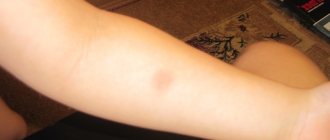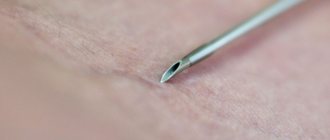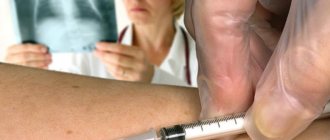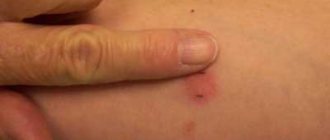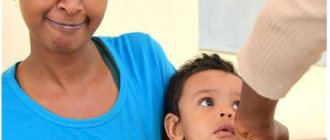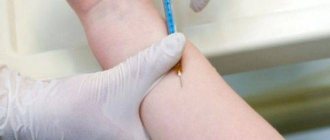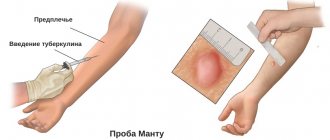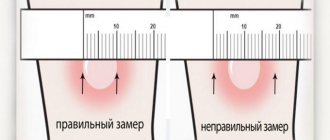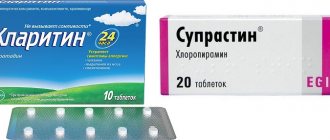Tuberculin diagnostics is the most common method for determining altered reactivity: to the human body resulting from infection with MBT or BCG vaccination.
The basis of tuberculin diagnostics is tuberculin tests. Tuberculin tests are performed using tuberculin. The valuable property of tuberculin is its specificity, since only the infected organism responds to its administration.
- Tuberculin Types of tuberculin
- Turn
Indications for Tuberculin vaccination
Tuberculin is used for tuberculin diagnostics (carrying out an intradermal Mantoux tuberculin test), which is an indicative diagnostic test for the purpose of:
- identifying the need for a patient to be vaccinated against tuberculosis with BCG
- diagnosis of tuberculosis;
- determining whether the population is infected with Mycobacterium tuberculosis (or the state of hypersensitivity to tuberculin, if the existing post-vaccination allergy does not give grounds to talk about infection).
The active substance of the drug (allergen-tuberculoprotein) causes, when performing an intradermal tuberculin test in people infected or vaccinated with BCG/BCG-M, a specific delayed-type hypersensitivity reaction in the form of a local reaction - hyperemia (redness) and infiltrate (papule formation).
Causes and risks
Very often, the detection of an abnormal tuberculin test means that a person has begun to develop active type tuberculosis. But such an outcome is not always observed, therefore, before starting treatment and seriously worrying about your health, you need to undergo an examination, since even a doctor cannot insist on a diagnosis of “tuberculosis” only based on the results of the Mantoux test. Correct conclusions are possible only in combination with additional research methods, and they do not always confirm such a diagnosis.
This reaction can occur in several cases. This:
- formation of tuberculosis;
- the presence of tuberculin infection in the patient’s body;
- allergy to the administered drug;
- skin sensitivity;
- unbalanced diet;
- improper care of the injection mark;
- incorrect procedure technique;
- using a low-quality or expired drug;
- carrying out the test if there are contraindications.
This means that sometimes the deviation is detected due to erroneous actions of the doctor or patient, and when the sample is repeated or during additional tests, the true results are revealed. In other cases, the test results are correct, but this does not mean that the patient's health is in serious danger.
In such a situation, he needs to be somewhat more careful in his behavior, but there is no need to start active treatment. And only some patients, in the presence of a turn, are diagnosed with an active form of tuberculosis, which requires treatment.
Patients are interested in what to do if the doctor talks about such a diagnosis. First of all, you need to contact a specialist so that he can prescribe the necessary tests. Since even a doctor cannot draw conclusions about the patient’s well-being from one Mantoux test, an examination is necessary.
Often during such an examination it is discovered that this result does not pose any danger, since it was provoked by disorders in the body of a completely different type. Once they are eliminated, the reaction normalizes.
At the same time, one cannot be careless when identifying a Mantoux turn. Sometimes it indicates that the human body has been infected, and there is a risk of the disease becoming active. This must be avoided, and in this case, timely diagnosis and quality treatment are necessary to minimize the consequences.
Evaluation of Mantoux test results
The test result is assessed by a doctor or trained nurse 72 hours after the test. A reaction to tuberculin is possible in the form of hyperemia (redness of the skin) and the formation of a papule (a dense round area rising above the skin). Assessment of the Mantoux test consists of taking into account the size of the papule and assessing the severity of hyperemia. The measurement is carried out in a direction transverse to the axis of the hand, the result is taken into account in millimeters. Only the size of the papule is measured, and not the size of the area of hyperemia (redness). The size of the redness is taken into account only when the papule has not occurred.
Reaction options for the Mantoux test:
- negative - there are no changes on the skin;
- doubtful - there is redness of any size without a papule, or a papule no more than 2-4 mm;
- positive mild - papule size 5-9 mm;
- positive of medium intensity - papule size 10-14 mm;
- positive pronounced - papule size 15-16 mm;
- excessive (hyperergic) - the size of the papule exceeds 17 mm or there are pronounced signs of inflammation (reaction of the lymph nodes, skin ulceration, etc.).
- A negative Mantoux reaction indicates that the body does not have antibodies that are “familiar” with the tuberculosis bacterium. This means that the child is not infected, or there is no immune reaction to BCG vaccination.
- A questionable sample is considered negative.
- A positive test can be either a consequence of BCG vaccination or a sign of infection.
To assess the likelihood of infection, you need to look at the turn of the tuberculin test - the transition of a negative Mantoux reaction to a positive one (not associated with previous vaccination) or an increase in the diameter of the papule compared to the result of the previous test by 6 millimeters or more.
Also signs of infection are:
- hyperergic reaction;
- persistent (more than 4 years) persistent reaction with a papule of 12 mm or more;
- gradual (over several years) increase in sensitivity to tuberculin with the formation of an infiltrate measuring 12 mm or more.
A positive Mantoux test result without taking into account other diagnostic criteria is not a basis for making a diagnosis or starting any treatment.
Only a doctor can evaluate the reaction; if necessary, the child will be referred for additional examination to a TB specialist.
How is this diagnosis made in children?
The procedure is carried out in a specialized room, where a laboratory assistant administers the vaccine subcutaneously. Blood cells - tools of the immune system - are sent to the place where the injection is made. The result is determined after three days. From the moment of entering the sample, you should not scratch the injection site for 72 hours. Based on the size of the formed convex zone (papules), conclusions are drawn taking into account the above symptoms and signs.
Examples of deciphering Mantoux results
The following options for assessing the result are possible:
- with minimal redness and absence of papule, it is considered negative;
- if the papule appears minimally, its diameter is no more than 4 millimeters, it is accepted as doubtful;
- if the convex area is scarlet in color and its size is more than 5 millimeters, it is considered positive;
- the presence of erosion at the injection site and papules with a diameter of more than 17 millimeters indicate hyperergic reactions (infection of the body).
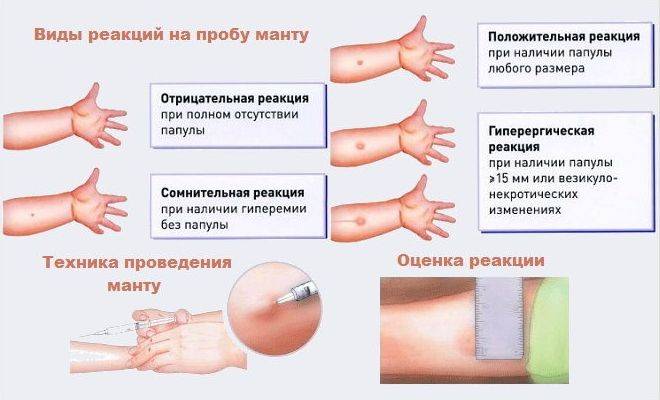
If the result is positive, the existing antibodies to the tuberculosis bacillus collide with the injected tuberculin, which indicates its presence in the body. In this case, doctors prescribe pharmaceutical drugs to stop the development of tuberculosis (isoniazid, rifampicin). The products are indicated for use if the infection is detected with one hundred percent probability. They are recommended when the patient comes into contact with a person suffering from tuberculosis infection. The drug "Isoniazid" is taken in a course lasting about two months. The dose is calculated as follows: 10 milligrams of active substance per kilogram of body weight. Its effectiveness against Koch's bacillus has been proven: in ninety out of a hundred infected people, interruption of the developing disease was detected.
Indications for the Mantoux test
The Mantoux test is performed to diagnose tuberculosis.
Children vaccinated against tuberculosis:
The Mantoux test (Intradermal allergy test with tuberculin) is performed once a year, regardless of the results of previous tests, at the age of 1 to 7 years inclusive.
For children not vaccinated against tuberculosis (children who have not been vaccinated with BCG), the Mantoux test is performed 2 times a year starting at the age of 6 months
Children not vaccinated against tuberculosis:
The Mantoux test is performed - 2 times a year, starting from the age of 6 months, the Mantoux test is performed.
Procedure for carrying out the tuberculin reaction
The Mantoux reaction is a research method during which tuberculin, a special substance consisting of metabolic products of Mycobacterium tuberculosis, is introduced into the body. You can definitely answer the question: is it possible to become infected after tuberculin testing? The drug does not contain bacteria of those species that provoke the development of a pathological process, so it is impossible to get sick after tuberculin tests.
If a person has an active tuberculosis process, then his body produces antibodies to the causative agent of the disease. When immunodiagnosis is carried out with tuberculin, the antibodies come into contact with the components of the drug, which is why an inflammatory process develops in the injection area.
Externally, it is manifested by skin symptoms - severe redness, the formation of infiltration (papules), itching. If the listed signs of inflammation are detected, the patient is referred for examination to a phthisiatrician to confirm the diagnosis of tuberculosis and prescribe treatment.
Order of the Ministry of Health of the Russian Federation No. 109 establishes that tuberculin tests are carried out to identify pathology annually for children from the age of 12 months. After performing Mantoux on a child, the analysis result is compared with previous values in order to track the dynamics of the development of skin manifestations.
Contraindications
Only a doctor can decide whether the drug “Tuberculin” is suitable for testing for tuberculosis.
“Tuberculin” is contraindicated for persons with allergic and autoimmune diseases!
The use of Tuberculin is also contraindicated in the following cases:
- common skin diseases
- epilepsy
- acute, chronic infectious and somatic diseases during exacerbation; allergic conditions (rheumatism in acute and subacute phases, bronchial asthma, idiosyncrasies with pronounced skin manifestations during exacerbation).
It is not allowed to carry out the Mantoux test in those children's groups where there is a quarantine for childhood infections. The Mantoux test is performed 1 month after all clinical symptoms disappear or immediately after quarantine is lifted.
Main features
How can we determine that the phenomenon under discussion is taking place and make a diagnosis of a turn? There are the following symptoms and signs characteristic of this condition, which form a certain clinical picture. These include symptoms such as:
- At the initial stages, the injection site is red, there is pronounced swelling, the test is recognized as doubtful or positive;
- The size of the papule at the site where the tuberculin preparation was injected increases significantly over time - it reaches 17-20 mm;
- Ulcers, papules, and ulcers may also appear, concentrated in the injection area or spread over a much larger area, perhaps even along the entire inside of the forearm;
- Strictly speaking, a clear deviation of the sample can be declared even when there has been a significant, more than 6 mm, sharp increase in the focus of the local reaction or papules.
Usually, the increase in the reaction area is quite strong, sometimes so much that parents themselves can notice this condition, it is especially noticeable in young children - they may experience swelling of the entire forearm. There is no need to rush to conclusions in this case - one and a half to two days will not solve anything. Therefore, it is better to wait for a control measurement of the papule 72 hours (three days) after administration of the drug, and then, if the reaction does not return to normal by this time, get recommendations from the doctor on further actions in this situation.
The Mantoux reaction is assessed precisely at the site of administration of the substance. There is a misconception that doctors measure redness on the skin in children. Actually this is not true. At the injection site, in the center of the redness, a compaction (papule) stands out clearly; if you press on it with a finger or a ruler, it will turn white. When determining the reaction, it is the compaction that needs to be measured.
We can talk about tuberculin variation in the following cases:
- if after the first test the size of the papule exceeds 5 mm;
- if the repeated sample differs from the previous one by more than 6 mm;
- if more than 3 years have passed since the BCG vaccination, and the size of the papule exceeds 12 mm.
Sometimes more serious symptoms indicate that a child’s body is infected with tuberculosis, including:
- significant swelling at the injection site that does not go away for a long time;
- pronounced reaction: a red mark at the injection site up to the elbow and beyond;
- blisters, purulent ulcers, watery blisters at the injection site.
Possible side effects
- For most, the test process is asymptomatic.
- Headaches may rarely occur
- General weakness, sleep disturbances, and increased body temperature rarely develop.
- Individuals with altered reactivity experience allergic reactions.
- Considering the possibility of developing immediate allergic reactions (anaphylactic shock, Quincke's edema, urticaria) in particularly sensitive individuals, vaccinated persons must be provided with medical supervision for 30 minutes.
Come get vaccinated at Aqua-Doctor. A full range of vaccines for children and adults, family vaccinations - at a special price!
Call a doctor at home Make an appointment with a doctor Or by phone +7
Is the Mantoux reaction dangerous?
The diagnosis is an indicator of the possible presence of infection in the body, which requires additional research. In the presence of the disease, characteristic symptoms appear:
- decreased concentration;
- presence of loose stools, fever;
- sudden weight loss;
- pain in the chest area;
- increased body temperature;
- the presence of a strong cough.
From this it follows that the turn does not pose a danger on its own - without the presence of specific symptoms and confirmation of tuberculosis by the results of a comprehensive examination.
Treatment
Children with abnormalities are sent to a TB specialist for observation, further diagnosis and preventive treatment. They are included in group 6A of dispensary registration. Parents are interested in what to do during a Mantoux turn, and what the tactics for further actions are. Before visiting a TB doctor, general blood and urine tests are prescribed, and a chest x-ray is performed.
Next, the child undergoes Diaskintest, a quantiferon test. Evidence of tuberculosis infection is a high (above normal) CFP10+ESAT6 score. An epidemiological investigation is mandatory to determine the possible source of infection, the child’s living conditions are assessed, and all possible risk factors are determined.
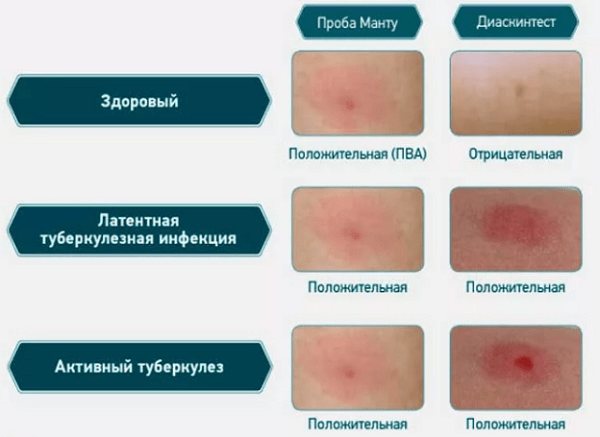
The decision to prescribe chemoprophylaxis is made only by a phthisiatrician. It consists of taking one anti-tuberculosis antibiotic for 3 months.

